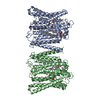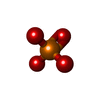[English] 日本語
 Yorodumi
Yorodumi- PDB-9ijy: Homo sapiens Xenotropic and Polytropic Retrovirus Receptor 1 (XPR... -
+ Open data
Open data
- Basic information
Basic information
| Entry | Database: PDB / ID: 9ijy | |||||||||||||||||||||
|---|---|---|---|---|---|---|---|---|---|---|---|---|---|---|---|---|---|---|---|---|---|---|
| Title | Homo sapiens Xenotropic and Polytropic Retrovirus Receptor 1 (XPR1) with Y22A/E23A/K26A mutations | |||||||||||||||||||||
 Components Components | Solute carrier family 53 member 1 | |||||||||||||||||||||
 Keywords Keywords | PROTEIN TRANSPORT / Pi exporter / a key regulator of cellular Pi homeostasis | |||||||||||||||||||||
| Function / homology |  Function and homology information Function and homology informationphosphate transmembrane transporter activity / phosphate ion transport / intracellular phosphate ion homeostasis / phosphate ion transmembrane transport / cellular response to phosphate starvation / inositol hexakisphosphate binding / efflux transmembrane transporter activity / response to virus / virus receptor activity / plasma membrane Similarity search - Function | |||||||||||||||||||||
| Biological species |  Homo sapiens (human) Homo sapiens (human) | |||||||||||||||||||||
| Method | ELECTRON MICROSCOPY / single particle reconstruction / cryo EM / Resolution: 2.64 Å | |||||||||||||||||||||
 Authors Authors | He, Q.X. / Zhang, R. / Chen, Q.F. / Li, B.B. | |||||||||||||||||||||
| Funding support |  China, 2items China, 2items
| |||||||||||||||||||||
 Citation Citation |  Journal: Nat Commun / Year: 2025 Journal: Nat Commun / Year: 2025Title: Structural basis of phosphate export by human XPR1. Authors: Qixian He / Ran Zhang / Sandrine Tury / Valérie Courgnaud / Fenglian Liu / Jean-Luc Battini / Baobin Li / Qingfeng Chen /   Abstract: Phosphorus in crucial for all living organisms. In vertebrate, cellular phosphate homeostasis is partly controlled by XPR1, a poorly characterized inositol pyrophosphate-dependent phosphate exporter. ...Phosphorus in crucial for all living organisms. In vertebrate, cellular phosphate homeostasis is partly controlled by XPR1, a poorly characterized inositol pyrophosphate-dependent phosphate exporter. Here, we report the cryo-EM structure of human XPR1, which forms a loose dimer with 10 transmembrane helices (TM) in each protomer. The structure consists of a scaffold domain (TM1, TM3-4) and a core domain (TM2, TM5-10) structurally related to ion-translocating rhodopsins. Bound phosphate is observed in a tunnel within the core domain at a narrow point that separates the tunnel into intracellular and extracellular vestibules. This site contains a cluster of basic residues that coordinate phosphate and a conserved W573 essential for export function. Loss of inositol pyrophosphate binding is accompanied by structural movements in TM9 and the W573 sidechain, closing the extracellular vestibule and blocking phosphate export. These findings provide insight into XPR1 mechanism and pave the way for further in-depth XPR1 studies. | |||||||||||||||||||||
| History |
|
- Structure visualization
Structure visualization
| Structure viewer | Molecule:  Molmil Molmil Jmol/JSmol Jmol/JSmol |
|---|
- Downloads & links
Downloads & links
- Download
Download
| PDBx/mmCIF format |  9ijy.cif.gz 9ijy.cif.gz | 186.9 KB | Display |  PDBx/mmCIF format PDBx/mmCIF format |
|---|---|---|---|---|
| PDB format |  pdb9ijy.ent.gz pdb9ijy.ent.gz | 143.3 KB | Display |  PDB format PDB format |
| PDBx/mmJSON format |  9ijy.json.gz 9ijy.json.gz | Tree view |  PDBx/mmJSON format PDBx/mmJSON format | |
| Others |  Other downloads Other downloads |
-Validation report
| Summary document |  9ijy_validation.pdf.gz 9ijy_validation.pdf.gz | 1.1 MB | Display |  wwPDB validaton report wwPDB validaton report |
|---|---|---|---|---|
| Full document |  9ijy_full_validation.pdf.gz 9ijy_full_validation.pdf.gz | 1.1 MB | Display | |
| Data in XML |  9ijy_validation.xml.gz 9ijy_validation.xml.gz | 37.9 KB | Display | |
| Data in CIF |  9ijy_validation.cif.gz 9ijy_validation.cif.gz | 52.8 KB | Display | |
| Arichive directory |  https://data.pdbj.org/pub/pdb/validation_reports/ij/9ijy https://data.pdbj.org/pub/pdb/validation_reports/ij/9ijy ftp://data.pdbj.org/pub/pdb/validation_reports/ij/9ijy ftp://data.pdbj.org/pub/pdb/validation_reports/ij/9ijy | HTTPS FTP |
-Related structure data
| Related structure data |  60645MC  9ijzC M: map data used to model this data C: citing same article ( |
|---|---|
| Similar structure data | Similarity search - Function & homology  F&H Search F&H Search |
- Links
Links
- Assembly
Assembly
| Deposited unit | 
|
|---|---|
| 1 |
|
- Components
Components
| #1: Protein | Mass: 83113.445 Da / Num. of mol.: 2 / Mutation: Y22A,E23A,K26A Source method: isolated from a genetically manipulated source Details: Residues 697-704 correspond to flexible linkers and residues 705-712 correspond to the strep ll tag. Among them, residue 22 tyrosine mutated to alanine, residue 23 glutamic acid mutated to ...Details: Residues 697-704 correspond to flexible linkers and residues 705-712 correspond to the strep ll tag. Among them, residue 22 tyrosine mutated to alanine, residue 23 glutamic acid mutated to alanine, and residue 26 lysine mutated to alanine. Source: (gene. exp.)  Homo sapiens (human) / Gene: XPR1, SLC53A1, SYG1, X3 / Production host: Homo sapiens (human) / Gene: XPR1, SLC53A1, SYG1, X3 / Production host:  Homo sapiens (human) / References: UniProt: Q9UBH6 Homo sapiens (human) / References: UniProt: Q9UBH6#2: Chemical | #3: Chemical | Has ligand of interest | Y | Has protein modification | Y | |
|---|
-Experimental details
-Experiment
| Experiment | Method: ELECTRON MICROSCOPY |
|---|---|
| EM experiment | Aggregation state: PARTICLE / 3D reconstruction method: single particle reconstruction |
- Sample preparation
Sample preparation
| Component | Name: Dimer of XPR1 mutant / Type: COMPLEX / Entity ID: #1 / Source: RECOMBINANT |
|---|---|
| Molecular weight | Value: 0.081535 MDa / Experimental value: NO |
| Source (natural) | Organism:  Homo sapiens (human) Homo sapiens (human) |
| Source (recombinant) | Organism:  Homo sapiens (human) Homo sapiens (human) |
| Buffer solution | pH: 7.4 |
| Specimen | Conc.: 4 mg/ml / Embedding applied: NO / Shadowing applied: NO / Staining applied: NO / Vitrification applied: YES |
| Vitrification | Cryogen name: ETHANE |
- Electron microscopy imaging
Electron microscopy imaging
| Experimental equipment |  Model: Titan Krios / Image courtesy: FEI Company |
|---|---|
| Microscopy | Model: TFS KRIOS |
| Electron gun | Electron source:  FIELD EMISSION GUN / Accelerating voltage: 300 kV / Illumination mode: FLOOD BEAM FIELD EMISSION GUN / Accelerating voltage: 300 kV / Illumination mode: FLOOD BEAM |
| Electron lens | Mode: BRIGHT FIELD / Nominal defocus max: 1600 nm / Nominal defocus min: 800 nm |
| Image recording | Electron dose: 49.97 e/Å2 / Film or detector model: TFS FALCON 4i (4k x 4k) |
- Processing
Processing
| EM software | Name: PHENIX / Category: model refinement | ||||||||||||||||||||||||
|---|---|---|---|---|---|---|---|---|---|---|---|---|---|---|---|---|---|---|---|---|---|---|---|---|---|
| CTF correction | Type: PHASE FLIPPING AND AMPLITUDE CORRECTION | ||||||||||||||||||||||||
| 3D reconstruction | Resolution: 2.64 Å / Resolution method: FSC 0.143 CUT-OFF / Num. of particles: 247144 / Symmetry type: POINT | ||||||||||||||||||||||||
| Refine LS restraints |
|
 Movie
Movie Controller
Controller



 PDBj
PDBj



